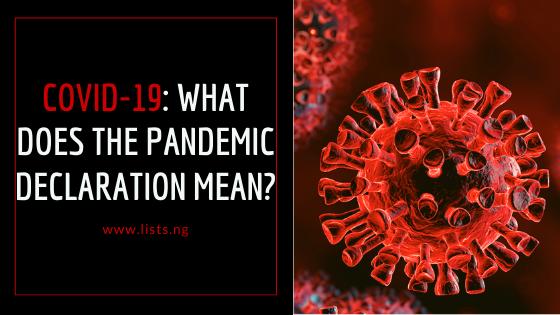The World Health Organisation has officially declared the Coronavirus, also known as COVID-19, a pandemic. The deadly virus which broke out in Wuhan China between December 12 and 29 has now spread to 108 countries with over 120,000 cases recorded and more than 4,300. The declaration has undoubtedly stirred up more panic across the world with markets crashing, and public gatherings such as sporting events, concerts, festivals being canceled. As the world tackles this disruptive pandemic and measures are put in place to contain its swift spread, here is what it all really means.
What is a Pandemic?
A pandemic is a disease epidemic that has spread across a large region; for instance multiple continents, or worldwide. Hence this WHO declaration has nothing to do with the severity of the COVID-19 rather it simply raises an alarm about its rapid spread across countries and continents.
How did the declaration come about?
Despite the fact that the corona virus had already begun to cross borders for a long time now, with cases in every continent except Antarctica, the WHO waited until yesterday March 11 to declare a pandemic. This is because the decision isn’t as straightforward as it seems. Generally, the WHO looks for sustained community outbreaks on different continents, and one key factor in a declaration is when people start becoming infected without obvious links throughout a population which has become the case across the world.
What does this mean
For some time now, COVID-19 has been regarded as an international emergency by the WHO, and this fresh pandemic declaration will no doubt add to the already widespread panic. However, WHO emergencies chief, Dr. Michael Ryan has cautioned that use of the word pandemic to describe the outbreak “is not a trigger for anything other than more aggressive, more intensive action.” The declaration is rather expected to move governments, individuals and health institutions to beef up preparedness to tackle and contain the spread.
Previous pandemics
Throughout history, there have been several pandemic outbreaks, from the the Black Death (1343-1353) to the Spanish flu of 1918 down to HIV/AIDS which was at its peak between 2005-2012. The most recent disease pandemic was the 2009 outbreak of “swine flu.” The disease was declared a pandemic after the new H1N1 flu had been spreading in multiple countries for about six weeks. See the deadliest pandemics in recent history here.
Does mean anything for its severity?
It is important that WHO’s pandemic declaration is not misconstrued for increased severity of the disease itself. The symptoms and effects of the disease remain the same, and many who contact the disease experience mild or moderate symptoms, such as fever and cough, and most recover in a couple of weeks. People who experience the more severe symptoms and at great risks are the elder citizens and people with existing health problems. More so, the COVID-19, while spreading faster, seems less deadly than other similar viruses such as SARS and MERS.






